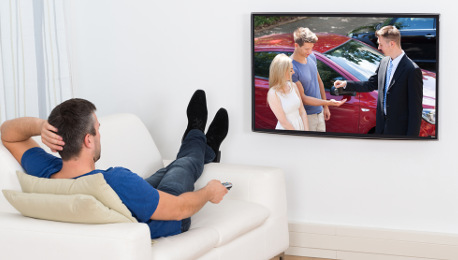Don’t pull the plug on TV car ads

In today’s digital world, television advertising is obsolete … or is it?
It’s a question many experts are pondering, and those in the auto industry are no exception.
A 2014 article in Dealer Marketing Magazine asked, “Does automotive marketing still rely too heavily on TV advertising?,” while one at NADAFrontPage.com touted a study suggesting that car shoppers are influenced most by TV advertising.
To help gain some perspective on the issue, Auto Remarketing talked to Jeremy Anspach, chief execuitve officer of digital advertising provider PureCars, which in October was acquired by Raycom Media.
Anspach stressed that what while digital advertising is a necessity given today’s high number of “cord cutters,” it’s not prudent to pull the plug on TV advertising.
While retail sales in general suffered in 2015, auto sales saw a record year. Anspach noted that many retailers have been quick to abandon TV in favor of digital, while he thinks the auto industry has understood the importance of maintaining a balance between the two.
“Put simply, car shoppers are still influenced by TV ads,” he said. “And these ads can still hold relevance across all industries if accompanied by a tailored digital strategy.
“It’s a marketer’s role to show the right message at the right time,” he continued. “When you look at the debates of whether or not you should be on television or not on television, I believe that a good marketer shows the right message at the right time on the right screen.”
Anspach pointed out that as Internet activity has increased, television activity has increased — in almost a near-linear fashion.
The hypothesis is that when one watches television, 87 percent of the time they have a second screen in their hand, or on their coffee table, or on their lap.
“We’ve become very ‘ADD’ if you think about it that way,” Anspach said.
A key, he said, is understanding how those screens work in harmony — specifically, how television stimulates online learning.
“There was research that shows that two-thirds of smartphone users will use their smartphone to learn more about a commercial that stimulated them,” Anspach said. “So let’s say a dealership is running an ad on television for a Silverado, and they’re presenting this $299 lease deal. Well, if the ad is effective, is doesn’t drive lot traffic directly, it drives online learning.
“If that dealer then isn’t investing in the right digital strategy, they need to assume that their competitor is — or one of their competitors — is. And the probability of that competitor wining from that dealership’s traditional TV buy is likely.”
Anspach said that the push toward online learning happens collectively.
“Because that dealership didn’t advertise a certain model doesn’t mean that no one is shopping for that model. So we’re looking for the micro-moments that stem from online learning, whether it’s search, whether it’s going to review sites, whether it’s going to YouTube,” he said. “There’s been huge growth in YouTube reviews from a viewer perspective, nearly 100 percent year over year. So we’re looking at all these different variables and saying ‘is this user showing intent on a vehicle the dealership (that’s our client) needs to sell, and, if so, showing a highly relevant message.”
Anspach talked about PureCars’ “SmartAdvertising” approach.
“We’re able to connect the dots across all screens and actually look for the micro-moments of a user that shows intent to buy a vehicle that the dealership has the need to market. And by doing this, it’s a balanced approach,” he said. “It’s not throwing all the dollars towards one media channel, it’s not all towards TV, it’s not all towards search, it’s not all towards display, video, social, etc. It’s about ‘look at the micro-moments’ of the user and if the dealership is running TV, we need to know that so we can ride the online learning journey post the ad.”
Anspach said that while PureCars as a company is a separate business unit of Raycom Media, the company is able to do a lot more with its clients in Raycom markets as it relates to connecting the dots.
“So in Raycom markets we oftentimes find their customers who buy TV from Raycom and leverage their auto solutions powered with PureCars that that balance is happening. So we as a company are programatically shifting the dollars throughout the month as we see the opportunities. Whether it’s a Raycom market or not we find this to be the biggest efficiency we solve for dealers across the country.”
All that being said, he’s observed extremes when it comes to auto advertising.
“I see dealers that oftentimes are on each end of the spectrum,” he continued. “At times they’re so heavy in traditional (advertising) that they’re completely lacking in digital, and at times the more ‘progressive’ dealer is highly digital with little to no traditional.
“Like any good advertiser,” he continued, “you have to look at the complete ecosystem and be sure you’re not putting too many eggs in one basket.”

 View The Latest Edition
View The Latest Edition

